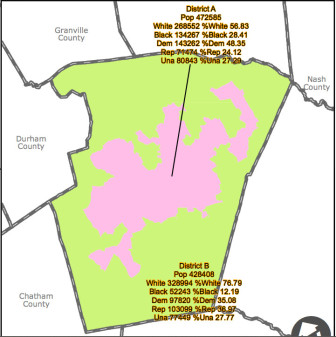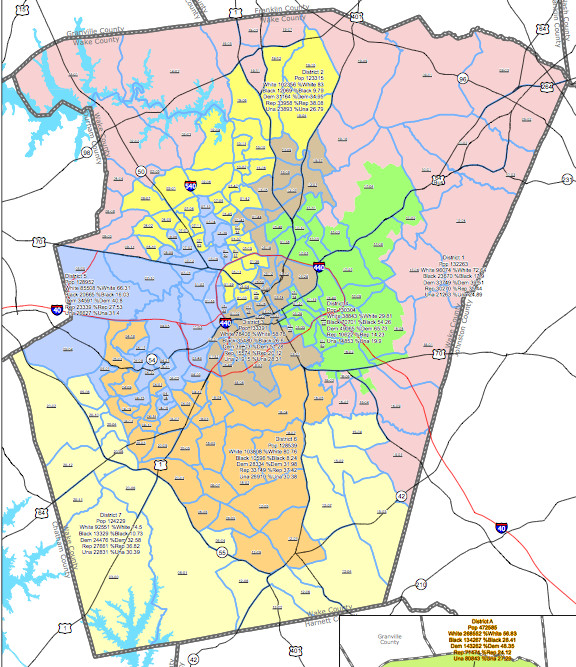A new redistricting plan means big changes and some musical chairs for the Wake County School Board.
State legislation to redistrict the school board, Senate Bill 325, was ratified June 13. Two Wake County Republicans — State Sen. Neal Hunt and State Sen. Chad Barefoot — proposed the bill, a move some have viewed as another power grab by the GOP.
This is the second redistricting of the Wake school board in two years. The previous one, in 2011, was legally mandated in accordance with the 2010 Census. Although that redistricting also was seen as giving Republican candidates an advantage, Democrats won a majority on the board that year anyway.
The Breakdown
School board members currently serve staggered four-year terms. This October, voters will elect members to Districts 1, 2, 7 and 9 as part of that process.
But in the future, school board elections will move from odd-numbered years to even-numbered years, which some have said could give Republican candidates an edge by syncing it with general elections.
To make the shift, the four members elected this year will serve shorter terms and there will be no school board election in 2015.
Under the new Wake school board redistricting plan, one school district will be cut up into pieces and absorbed by four new districts. Meanwhile, voters will have two school board members representing them instead of one, and two new districts will separate the urban areas of Wake County from the suburban, rural parts of the county.
In getting a closer look at how the new law will affect the school system, the Record obtained a copy of the redistricting maps from State Rep. Paul Stam, R-Wake, and compared them with voter statistics for the current districts from the Wake County Board of Elections and maps of current districts from Wake schools.
Click on lower left corner arrows for a full-screen view.
Here’s how the new law will affect four districts in the Wake system:
District 6, represented by Christine Kushner, Democrat
The Central Raleigh school district appears to be most affected by the new redistricting plan.
District 6 currently is roughly bounded by Broughton High School in the south, Sanderson High School in the north, River Bend High School and Mt. Vernon High School east-west. The area includes Five Points and other older neighborhoods along Glenwood Avenue.
The new map will cut up the district’s 74,364 voters and parcel them out to the new District 2, District 4 and 5, and the central part of the current district will become part of a sliver-thin new District 3.
District 4, represented by board Chairman Keith Sutton, Democrat
The current version of the district is the most stalwart Democratic of all districts, and looks to remain such on the new map.
District 4 currently has 67,118 registered voters, according to the Wake County Board of Elections’ tally as of early June, 65 percent of which are Democrats, 11.7 are Republicans, and 22.6 percent are unaffiliated.
The new District 4 expands upon the same area, and has 130,304 voters. Of those, 65.7 percent are Democrats, 14.2 percent are Republicans, and 19.9 percent are unaffiliated.
District 8, represented by Susan Evans, Democrat
District 8 has provided the two deciding votes on the board since the controversies over income-disparity bussing began.
In 2009, Ron Margiotta, Republican and then-chairman of the board, was from District 8, and along with the four newly elected Republican members, formed a majority to overturn the income-disparity bussing plan.
Then, when Margiotta lost to Democrat Susan Evans in 2011 – and when other Republican board members also failed to hold on to their seats that year – power dynamics on the board shifted again. Evans was among the five in favor of firing then-Superintendent Anthony Tata in 2012.
Currently, District 8 covers Holly Springs and Apex. On the new map, District 8 will not exist. The area will be absorbed into the new District 7, which goes from the western Wake County line, including Holly Springs and Apex, to the eastern county line, including Fuquay-Varina.
District 2, represented by John Tedesco, Republican
John Tedesco, the Republican board member who has been the most vocal proponent of keeping communities intact with a neighborhood schools busing plan, will see his district divided under the new law.
The current District 2 is comprised of Garner and Fuquay-Varina. On the new map, that area will be divided among District 7, which will take Fuquay-Varina and combine it with Holly Springs and Apex, and District 1, a sprawling new district that combines North Raleigh currently represented by Kevin Hill, and combine it with Zebulon, Wendell, Wake Forest, Rolesville and Knightdale.
The new District 2 will be tiny and unrecognizable from the current area. It will be tucked into a section of North Raleigh, north of the Beltline.
Districts A and B: The New “At-Large” Seats
The new at-large districts are huge. District A will be mostly urban, central Wake County, and District B will be rural, suburban Wake County.
District A currently has a population of 472,585, of which 48.4 percent are Democrats, 24.1 are Republicans and 27.3 percent are unaffiliated.
District B has a population of 428,408, of which 35.1 percent are Democrats, 37 percent are Republicans and 27.8 percent are unaffiliated.
